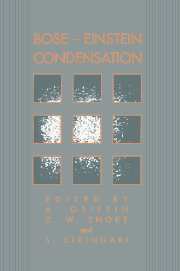Book contents
- Frontmatter
- Contents
- Preface
- Preface to paperback edition
- 1 Introduction: Unifying Themes of Bose–Einstein Condensation
- Part one Review Papers
- Part two Brief Reports
- 20 BEC in Ultra-cold Cesium: Collisional Constraints
- 21 BEC and the Relaxation Explosion in Magnetically Trapped Atomic Hydrogen
- 22 Quest for Kosterlitz–Thouless Transition in Two-Dimensional Atomic Hydrogen
- 23 BEC of Biexcitons in CuCl
- 24 The Influence of Polariton Effects on BEC of Biexcitons
- 25 Light-Induced BEC of Excitons and Biexcitons
- 26 Evolution of a Nonequilibrium Polariton Condensate
- 27 Excitonic Superfluidity in Cu2O
- 28 On the Bose–Einstein Condensation of Excitons: Finite-lifetime Composite Bosons
- 29 Charged Bosons in Quantum Heterostructures
- 30 Evidence for Bipolaronic Bose-liquid and BEC in High-Tc Oxides
- 31 The Dynamic Structure Function of Bose Liquids in the Deep Inelastic Regime
- 32 Possibilities for BEC of Positronium
- 33 Bose–Einstein Condensation and Spin Waves
- 34 Universal Behaviour within the Nozières–Schmitt-Rink Theory
- 35 Bound States and Superfluidity in Strongly Coupled Fermion Systems
- 36 Onset of Superfluidity in Nuclear Matter
- Appendix. BEC 93 Participant List
- Index
35 - Bound States and Superfluidity in Strongly Coupled Fermion Systems
Published online by Cambridge University Press: 15 December 2009
- Frontmatter
- Contents
- Preface
- Preface to paperback edition
- 1 Introduction: Unifying Themes of Bose–Einstein Condensation
- Part one Review Papers
- Part two Brief Reports
- 20 BEC in Ultra-cold Cesium: Collisional Constraints
- 21 BEC and the Relaxation Explosion in Magnetically Trapped Atomic Hydrogen
- 22 Quest for Kosterlitz–Thouless Transition in Two-Dimensional Atomic Hydrogen
- 23 BEC of Biexcitons in CuCl
- 24 The Influence of Polariton Effects on BEC of Biexcitons
- 25 Light-Induced BEC of Excitons and Biexcitons
- 26 Evolution of a Nonequilibrium Polariton Condensate
- 27 Excitonic Superfluidity in Cu2O
- 28 On the Bose–Einstein Condensation of Excitons: Finite-lifetime Composite Bosons
- 29 Charged Bosons in Quantum Heterostructures
- 30 Evidence for Bipolaronic Bose-liquid and BEC in High-Tc Oxides
- 31 The Dynamic Structure Function of Bose Liquids in the Deep Inelastic Regime
- 32 Possibilities for BEC of Positronium
- 33 Bose–Einstein Condensation and Spin Waves
- 34 Universal Behaviour within the Nozières–Schmitt-Rink Theory
- 35 Bound States and Superfluidity in Strongly Coupled Fermion Systems
- 36 Onset of Superfluidity in Nuclear Matter
- Appendix. BEC 93 Participant List
- Index
Summary
Abstract
The two-particle spectrum in a dense Fermion system is treated using a thermodynamic Green function approach. A self-consistent description of possible bound states and a superfluid condensate in a correlated medium is given.
A detailed understanding of superfluidity and superconductivity in correlated Fermion systems, especially the transition from the Cooper-paired state (weak-coupling limit) to the Bose condensed state of tightly bound pairs of Fermions (strong coupling limit) [1], is of great interest for very different physical systems. The problem of a unified treatment of Bose–Einstein condensation (BEC) and the Bardeen–Cooper–Schrieffer (BCS) phase arises not only in describing the electron structure of strongly correlated electron superfluids such as superconductors [2], the electronhole system in semiconductors [3], spin-polarized hydrogen and liquid He [4], but also in the theory of nuclear matter [5] and quark–gluon systems [6].
Recently, there have been several new approaches to this stimulating problem. A Monte-Carlo simulation of a finite He system at zero temperature has been performed in Ref. [7]. The microscopic theory of strongly coupled quantum fluids has been treated within the Jastrow approximation (cf. Ref. [8]) to obtain the ground state and low-lying excited states of strongly correlated boson quantum fluids. The crossover from weak to strong coupling superconductivity has been considered using a functional integral representation [2] (see also Ref. [7]).
- Type
- Chapter
- Information
- Bose-Einstein Condensation , pp. 574 - 583Publisher: Cambridge University PressPrint publication year: 1995



